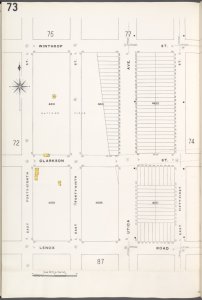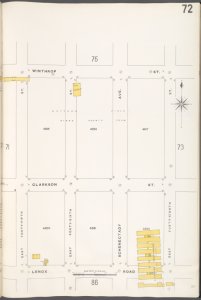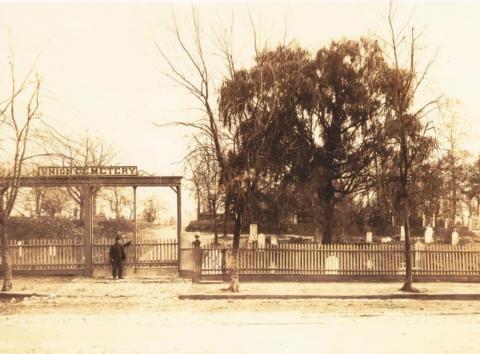The following post was originally published in 2014, by an NYG&B intern. We would like to share it with you again, since it's a very interesting subject and features some original research Brandon did while interning with us. We would like to thank everyone who supports our intern program through generous donations. If you would like to sponsor an NYG&B intern, please consider making a donation today.
Back when I was younger, I thought that burying the deceased was formal, dignified, and always a well-recorded event. While interning at the NYG&B, I realized this was not always the case.
My assumption was first challenged when my parents first told me about the African Burial Ground in Lower Manhattan, since it was a case where people tried to forget about the dead. While my project had nothing to do with the African Burial Ground, this place gave me the inspiration to do research on a place where the dead have been long “forgotten.” That was when my mind turned to potter’s fields, or places where only the impoverished could be buried.

Digital ID: 1810878. NYPL
I started doing research on what potter’s fields used to exist in New York City, and this search took me through a book called The Fairchild Cemetery Manual: A Reliable Guide to the Cemeteries of Greater New York and Vicinity. While looking at this book, I noticed a mention of a potter’s field called “Kings County Cemetery.”
I found this strange, because I have never heard of a “Kings County Cemetery.” It was a place prominent enough to be in the guide, yet now hardly anybody talks about it, save the occasional forum about a “County Farms Cemetery” (another name for Kings County Cemetery) on Ancestry.com. I wanted to find out more about this place, since it went from having some notoriety to disappearing into near-complete obscurity.
The initial information I looked for was on the location of the field, to make sure that the potter’s field really did exist. This search took me through the New York Public Library’s digital maps (http://digitalgallery.nypl.org/).
As it turned out, some of the digital maps in their collection were property maps of Flatbush, the neighborhood the potter’s field was in. Through the property maps, I found out that the field was on Clarkson Avenue (labeled Clarkson Street on the property maps I found), east of the current Kings County Hospital Center but west of Utica Avenue.
I also found out a lot about the story of this potter’s field through The Brooklyn Daily Eagle‘s archives, which is on http://bklyn.newspapers.com/. Through the paper, I learned about when the place was open (from 1853 to 1917), and I also found out how many bodies the potter’s field had (over 100,000 people by the time the place closed). While these statistics are important, they ignore the tumultuous history of the field. It was a history marked by the threat of building over the field. It was a threat that was openly talked about by The Brooklyn Daily Eagle in 1913, when the building of Winthrop Street (the street north of Clarkson Avenue) happened over a part of the potter’s field.
The building of Winthrop Street was viewed as a sign of progress by the paper, and on a number of occasions the paper viewed the presence of the potter’s field as a symbol of blight. In spite of the disagreeable presence of the place, the circumstances involving the potter’s field closure (including the disinterments that followed) were equally disagreeable. This was because many thought that the presence of disinterred bodies out into the open air was a health hazard.

Digital ID: 1810877 NYPL
As it turned out, it was the issue of disinterments that took up much of my research time. When this potter’s field was asked about on Ancestry.com, a poster suggested that the bodies were re-interred to the Hart Island Potter’s Field (also known as City Cemetery) in The Bronx. This issue led me to the New York Municipal Archives, since they have Hart Island records.
I asked whether they have any records showing that bodies were re-interred from the potter’s field on Clarkson Avenue to Hart Island. To their knowledge, there was no reinterment of Kings County Potter’s Field bodies to Hart Island. Further research on disinterments from Kings County Potter’s Field ended up showing that the Municipal Archives was almost certainly correct; The Brooklyn Daily Eagle’s article on the closure of the potter’s field said that the bodies would be moved to North Brother’s Island (North Brother Island, a currently abandoned island northwest of Rikers Island).
Unfortunately, I was unable to confirm (or deny) for sure that the bodies were re-interred to North Brother Island. However, in my efforts to confirm the reinterments, I was also able to find out that a potter’s field existed on North Brother Island. I managed to find out about a potter’s field even more hidden in local history than the one on Clarkson Avenue in Flatbush; since so little is known about these potter’s fields, The Brooklyn Daily Eagle and forum posts on Ancestry.com are the only sources which mention what happened to the bodies that used to be at Kings County Potter’s Field.
While nothing can be said for sure, a 1917 article from The Brooklyn Daily Eagle on the Kings County Potter’s Field closure is probably more believable than a forum post made over 90 years after the field closed.
This does not necessarily disprove that there are still bodies under the former potter’s field. In fact, the building of Winthrop Street over a part of the potter’s field (without any talk of disinterments in The Brooklyn Daily Eagle) leads one to think that there might be some bodies under that street.
Then there is the parking lot on the northeast corner of where the potter’s field used to be (near Winthrop Street and Utica Avenue); this is the one area of the former potter’s field property that has never been developed. If there are bodies below the current property (Kingsboro Psychiatric Center), it might be below the parking lot.
Regardless of whether the bodies were re-interred to North Brother Island, the uncertain status of where the bodies lie reflects on the truly forgotten nature of these people. Such was the lack of dignity given to the impoverished dead.
Sources:
Brooklyn Property Maps Showing the Potter’s Field:
Brooklyn V. 10, Plate No. 72 [Map bounded by Winthrop St., E. 48th St., Lenox Rd., E. 45th St.]. http://digitalgallery.nypl.org/nypldigital/dgkeysearchdetail.cfm?trg=1&strucID=1905946&imageID=1810877&total=131&num=60&parent_id=1902778&s=¬word=&d=&c=&f=&k=1&sScope=&sLevel=&sLabel=&lword=&lfield=&sort=&imgs=20&pos=75&snum=&e=w.
Brooklyn V. 10, Plate No. 73 [Map bounded by Winthrop St., E. 51st St., Lenox Rd., E. 48th St.]. http://digitalgallery.nypl.org/nypldigital/dgkeysearchdetail.cfm?trg=1&strucID=1905947&imageID=1810878&total=131&num=60&parent_id=1902778&s=¬word=&d=&c=&f=&k=1&sScope=&sLevel=&sLabel=&lword=&lfield=&sort=&imgs=20&pos=76&snum=&e=w.
Various reports on the Kings County Potter’s Field
Fairchild Sons. Fairchild Cemetery Manual: A Reliable Guide to the Cemeteries of Greater New York and Vicinity. Brooklyn, NY: Fairchild Sons, 1910.
“New Street Invades Paupers’ Graveyard.” The Brooklyn Daily Eagle, 22 Aug. 1913.
“Keeper of God’s Acre Soon to Lose Place.” The Brooklyn Daily Eagle, 1 Jul. 1917.
“Paupers Burial Ground a Disgrace to the City.” The Brooklyn Daily Eagle, 3 Jun. 1906.
Talk of a potter’s field on North Brother Island:
Horton, Sydney. “Chapter Spotlight: Safe Harbor.” http://archive.audubonmagazine.org/fieldnotes/fieldnotes0501.html
